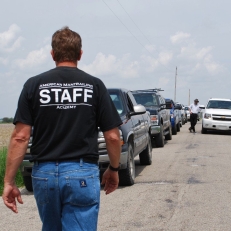

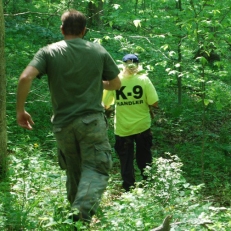
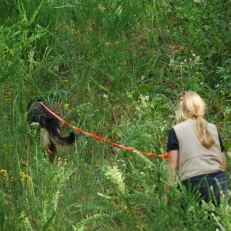
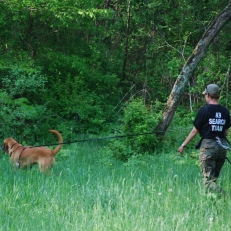
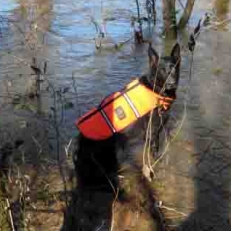



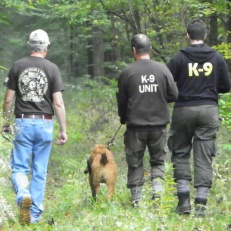

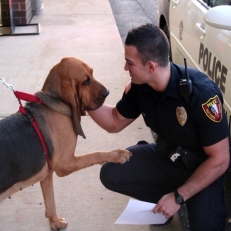

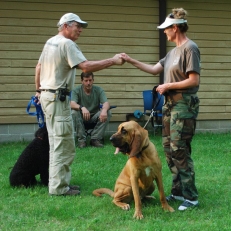
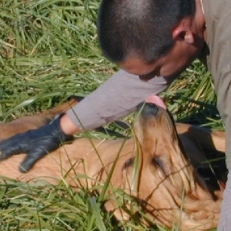



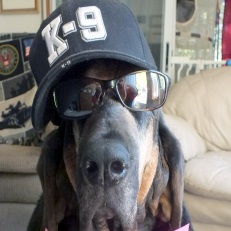


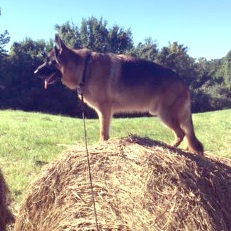
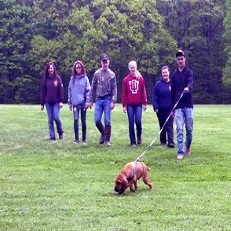




Click here for the AMPWDA Code of Ethics and Bylaws.
AMPWDA Certification Standards
Effective January 1, 2025
| 1. | Candidate must be a member in good standing. |
| 2. | Certifications will be conducted at AMPWDA Seminars and / or designated Certification days. Each paid registration to an AMPWDA Seminar or AMPWDA Certification day will entitle the payee to one (1) certification attempt. A retest may be available, time permitting |
| 3. | All AMPWDA Certifications will be valid for two (2) years or one (1) year, depending on the discipline. The Certification is only valid so long as the member is in good standing, and the AMPWDA Code of Ethics and Bylaws are upheld. |
| 4. | All AMPWDA Certifications are for the canine and handler that complete the test. The Certifications are not valid in any other combination of canine and handler. |
| 5. | AMPWDA reserves the right to cancel any Certification for violation of the AMPWDA Code of Ethics and Bylaws. |
| 6. | AMPWDA will not refund any Certification or Academy fees if the AMPWDA member is removed for violation of the AMPWDA Code of Ethics and Bylaws. |
| 7. | All Certification Tests are pass or fail, based on the criteria listed below. Final determination is up to the AMPWDA Master Trainer and will not be open for debate.. |
All Mantrailing
Certifications
Will Be Tested Double-Blind With GPS Verification
Double-Blind - Only the K-9, handler, and optionally a backup will
go on the trail (No One Who Has Knowledge Of The Trail Can Go On The
Trail)
GPS Verification - The team must cover at least 70%
of the trail. This does not mean you need to be right on the trail,
but you must follow it's flow. There is no penalty for getting off
trail and correcting.
All Mantrailing Certifications are valid for two (2) years.
RETESTS - At all events offering certification testing, the
following are allowed based on certification level.
Levels 1
& 2: As long as time permits, one retest will be provided.
Level 3: As long as time permits, one retest
at a lower level will be provided.
Urban: As long as time
permits, one retest will be provided.
Master Mantrailing
Challenge: No retests will
be permitted due to time requirements for running this test.
The team (K9/Handler) must have certified Level 2 before attempting Level 3 and must have certified Level 3 before attempting Level 4. Although not required, we highly recommend completing Level 1 before attempting a Level 2.
BASIC
AMPWDA Level 1 Mantrailing
The trail will be a minimum of thirty (30) minutes old and approximately one half (.5) of a mile in distance. The trail will cover at least three (3) surfaces and have at least one (1) 90 degree turn. There will be no intentional cross trails. A scent article may be used. Handler, Canine and one (1) Person Backup will be permitted. The runner will be waiting at the end of the trail. The K9 team will be given ten (10) minutes to start the trail and thirty (30) minutes to complete the trail.
AMPWDA Urban Mantrailing
The trail will be a minimum of forty-five (45) minutes old and approximately three quarters (.75) mile in distance. There may be one (1) or more major road crossings. There will be an intentional cross trail. There will be at least two (2) ninety (90) degree turns. Trail will laid in an urban or suburban setting with the majority of the trail on hard surface. Scent article may be used. Handler, Canine and one (1) Person Backup will be permitted. The runner will be waiting at the end of the trail. The K9 team will be given ten (10) minutes to start the trail and forty-five (45) minutes to complete the trail.
EXPERT
AMPWDA Level 2 Mantrailing
The trail will be a minimum of one (1) hour old and approximately one (1) mile in distance. The trail will cover at least four (4) surfaces, have at least one (1) road crossing, at least one creek crossing(if available) and multiple turns. There will be at least one (1) intentional cross trail. A scent article may be used. Handler, Canine and one (1) Person Backup will be permitted. The runner will be waiting at the end of the trail. The K9 team will be given ten (10) minutes to start the trail and one (1) hour to complete the trail.
DISTINGUISHED EXPERT
AMPWDA Level 3 Mantrailing
The trail will be a minimum of four (4) hours old and approximately one (1) mile in distance. The trail will cover at least four (4) surfaces, have at least one (1) road crossing, at least one creek crossing(if available) and multiple turns. There will be one (1) or more intentional cross trail. A scent article may be used. Handler, Canine and one (1) Person Backup will be permitted. The runner will be waiting at the end of the trail. The K9 team will be given ten (10) minutes to start the trail and one and one quarter (1.25) hours to complete the trail.
The AMPWDA MASTER Mantrailing
Challenge
AMPWDA Level 4 Mantrailing
As yet, no team has successfully completed this challenge. Like the above listed Mantrailing Certifications, this challenge will be run under double-blind protocol with GPS verification - the team must cover at least 70% of the trail. This does not mean you need to be right on the trail, but you must follow it's flow. There is no penalty for getting off trail and correcting.Any team that successfully completes this challenge will be awarded the AMPWDA Master Mantrailing Challenge Trophy and Certification. The trail will be between twenty-four (24) hours and twenty-six hours old and approximately one and one quarter (1.25) miles in distance. The trail will cover at least four (4) surfaces, have at least one (1) road crossing, at least one creek crossing(if available) and multiple turns. There will be be one (1) or more intentional cross trail. A scent article may be used. Handler, Canine and one (1) Person Backup will be permitted. The runner may or may not be waiting at the end of the trail. If the runner is not present, a large scent article will be left and the trail end will be clearly marked. The K9 team will be given ten (10) minutes to start the trail and one and one half (1.5) hours to complete the trail.
AMPWDA Human Remains Detection
(LAND)
Human Remains Detection (LAND) Certifications are
valid for one (1) year.
CLICK
HERE for PDF of HRD
Land Certification Standards
Be Sure You Have The 2025 Version
Displayed - if not, refresh.
AMPWDA Human Remains Detection
(WATER)
Human Remains Detection (WATER) Certification is
valid for two (2) year.
This test is designed to resemble practical searches within normal
operational environments. This test will evaluate the handler’s
ability to understand the environment, come up with a search plan,
and to evaluate the canine’s ability to recognize and respond to
target odor in water.
The handler will be able to recognize the canines alert and be able
to articulate where the submerged target odor is located.
Prerequisites:
· Crime Scene Preservation Class
· Blood-borne Pathogens and Hazmat (may be combined)
· Training records or other proof that training records which meet
the industry standards are being maintained for the previous 6
months.
· The dog and handler must be in sufficient health to complete the
evaluation.
· The dog must be a minimum of 1 year old, the handler is preferred
to be a minimum of 18 years old.
· Provide proof of successfully completing Land HRD certification
that meets or exceeds AMPWDA standards.
Water Certification Evaluation:
TRAINING AID WILL BE PLACED A MINIMUM OF 30 MINUTES PRIOR TO START
OF TESTING
This test will be conducted in an uncontaminated body of water (an
area of which no training aids have been placed within the last 48
hours)
Shoreline
● The handler will articulate to the evaluator how the canine will
respond in the presence of the target odor.
● Target odor will consist of human tissue/bone
● Target odor will be no less than 8 ounces/.5 pound
● The search area will be no less than 50 yards in length
● Target odor will be no more than 12ft from shore
● Target odor will be placed a minimum of 3 feet deep
● Handler will be given 15 minutes for this search
Open Water/Boat Search
TRAINING AID WILL BE PLACED A MINIMUM OF 30 MINUTES PRIOR TO START
OF TESTING
This test will be conducted in an uncontaminated body of water (an
area of which no training aids have been placed within the last 48
hours)
● Successfully passed the shoreline portion of this evaluation
before moving to boat work.
● A lake or pond with a search area at least 4 acres
● Target odor will be a minimum of 2 pounds consisting of human bone
and tissue and safely secured in a perforated container.
● Target odor will be placed a minimum 10ft deep.
● The canine’s response should be within a radius of double the
depth from where the target odor is placed (example – target odor is
6’ deep, canine response should be within a 12’ radius of target
odor).
● Handler will articulate the search strategy to boat driver.
● Boat driver will comply with what is asked by the handler in the
means of how the area will be searched. No guidance will be given
from the boat driver.
● Handler will have 1 hour to complete the search.
The passage of the HRD Certification will be based on the following:
The successful identification of 100% of the target odors, based on
the handler’s recognition/interpretation of the canine behavior.
Reasonable variances will be granted based on the search environment
and the type and size of target odor used.
The canine must perform an independent and recognizable trained
final response.
Evaluator discretion concerning the trained final response may be
based on the type of search and environmental circumstances so long
as the same discretion is extended to each handler and canine at the
test venue.
This is a pass or fail test.
No make-up stations will be permitted due to the nature of the
environment, water contamination from previously placed source and
time involved in the moving and replacing of water sources.
The
evaluator’s opinions and decisions are final.
AMPWDA Air Scent Live Find
Air Scent Live Find Certifications
are valid for two (2) years.
Prerequisite Courses &
Requirements - Handler must provide copies of certificates/proof
of the following:
Crime Scene Preservation Course, ICS-100 & ICS-700, Up to date training logs,
and AKC CGC or equivalent.
Prerequisite Physical Condition - Handler and dog must be able to physically complete all tests. It is recommended that the dog be rated a “5”, as per the Purina Body Condition System. The Master Trainer reserves the right to stop any tests based upon the physical abilities and/or safety of the dog or handler.
Additional Requirements/Parameters*
Pretest - Any K9 Team who has not previously certified in Air Scent
Live Find with AMPWDA will be required to complete a pretest. This
test will be given in an area of approximately 5 acres. A path will
be clearly marked and the handler must remain within the boundaries
of that path at all times. K9 must search independently and
perform their TFI. K9 has 10 minutes to complete this test.
Due to time requirements and land availability, requests for Level
II & Level III tests must be requested a minimum of 31 days in
advance by either email or snail mail. It is required that an AMPWDA Level I is successfully completed before
attempting a Level II or Level III.
Each K9 team is permitted to have a flanker of their choosing. The
flanker can NOT have been in the test area within 6 months of the
test.
If K9 locates victim, leaves the victim and does NOT perform its
TFI, it is an automatic fail.
*AMPWDA, at its discretion, may waive any part as deemed appropriate
Level 1 – Basic SearchLocate a single stationary subject in a pre-defined 40-60 acre area, within 1.5 hours, including breaks. A GPS may be used.
Level 2 – Intermediate Search
Locate a single stationary subject in a pre-defined 60-80 acre area, within 3 hours, including breaks. A GPS may be used.
Level 3 – Advanced Search
To achieve the Level 3 certification, the team must successfully complete both a night and day search. The Master Trainer reserves the right to conduct tests on a single or multiple days. A GPS may be used for both searches.
Night Search: Locate a single stationary subject situated within an 80+/- acre area, within 3 hours, including breaks.
Day Search: Locate two moving subjects located within a 140-160 acre area, within 4 hours, including breaks.
AMPWDA
Police Service Dog
Police Service Dog Certifications are
valid for one (1) year.
Certification testing will be performed in each of the following five (5) categories. A separate certification will be awarded for the passing of each individual category. When the the K9 team holds a current certification in all categories, they will receive a certification for the title 'Police Service Dog'.
1) Obedience Testing
Obedience is the foundation of all dog training and, during the course of its instruction, builds an important bond between the handler and canine. Additionally, a trained and certified police service dog must demonstrate obedience as it ensures that the dog will perform as expected when deployed and reduces liability for the team and their respective department. As such, passing the obedience evolution is a requirement for certification.
The testing will include the following exercises: sit, down, stay, recall (at a distance), heel (3 speeds: slow, normal, double time), right turn, left turn, about turn, and down in motion.
The team must be able to complete the following exercises utilizing both hand and/or voice commands when instructed to do so by the Master Trainer: sit, down, stay, recall.
The order in which the exercises are to be performed will be determined by the Master Trainer at the time of testing.
Though pinch/prong collars are allowed for this evolution, electronic correction collars will not be permitted. Further, any handler giving excessive, unnecessary or undue corrections will be asked to leave and be given an overall failure for the certification.
This is a pass/fail evolution and successful completion is required to advance to the next evolution.
2) Criminal Apprehension/ Handler Protection
The intention of this evolution is to test the team’s ability to apprehend a person whom may be fleeing the police and needs to be taken into police custody. This evolution will also measure the canine’s ability to apprehend and a suspect and hold them until the handler can arrive to safely take the suspect in custody.
It is the intention of this evolution to test the canine’s ability to deploy when it recognizes that the handler is being assaulted or at the command of the handler when an assault is imminent.
This evolution shall be administered in the following manner:
a. The handler and canine will approach a suspect and attempt to question them relative to a crime they may be involved in. The suspect will show passive resistance by simply verbally refusing to speak to the police at first. Then, the suspect will begin to walk away and eventually begin running from the police. The canine will be deployed to apprehend the suspect as he is fleeing.
b. The handler will "out" his dog and place it in a sit or down stay position or recall to a finish position.
c. The suspect will, in a standing position, be positioned in such a fashion so as to simulate a pat-frisk or search incident to arrest. This is a two repetition exercise. One pat down will be executed with no assault on the handler. The second will be when the suspect pushes away from the handler. The canine will apprehend the suspect.
d. The handler will "out" his dog and place it in a sit or down stay position or recall to a finish position.
e. The team will respond to an area designated by the Master Trainer, approximately 30-40 yards away from the suspect. The handler will be instructed to send his dog to apprehend the suspect. When the dog is clearly fixed on the suspect, the handler will recall his dog.
The following considerations shall be adhered to relative to this evolution:
a. The handler will be required to use verbal commands given to the suspect before deploying his dog, as would occur in the field as in a real life deployment.
b. During the handler protection exercises, the dog must apprehend the suspect that assaulted the handler with or without command.
c. During the recall, the handler is to send his dog from the "finish" or "heel" position. The handler is not to move from their position. The dog must be recalled to the handler or be in a down/sit in motion. A failure will be issued for the entire evolution if the canine comes in contact with the suspect in any way during this exercise.
d. The first exercise of the evolution (long-send apprehension) and the final exercise of the evolution (recall) may be done during gunfire, blanks only, at the Master Trainer’s discretion. If evoked, there will be a minimum of 2 shots fired.
3) Area Search (Suspect)
The intention of this evolution is to determine the dogs ability to search and commit to searching for a suspect in a predetermined area. This area may be an open field, or a portion of a wooded area.
The Master Trainer shall put a suspect in a pre-determined location within the area to be searched. The dog will be deployed off leash and directed to search the area only after the handler issues to appropriate warnings.
This is a timed evolution. The time shall be determined by the Master Trainer and varies based on the area to be searched. The test can be terminated if the Master Trainer determines that the dog is no longer working or if the suspect is not apprehended within the time limit.
The dog must apprehend the suspect to successfully complete the evolution.
This evolution will require the handler to take a tactical approach to their search of the area and maintain officer safety considerations. Though not a reason for evolution failure, the Master Trainer will recommend remedial training for the handler if obvious and egregious officer safety issues should arise during the exercise.
4) Building Search
This evolution is designed to simulate a real-world situation and, accordingly, is designed to test the canine’s ability to search a building in an attempt to apprehend a suspect.
There will be 3 types of buildings used: a residence, a warehouse or commercial building, and a school.
The suspect will be hidden in an area pre-determined by the Master Trainer and will be hidden for at least 10 minutes prior to the search. They will be placed in an area of concealment from the team and will be, if possible, a person unknown to the dog.
The test must be done off leash and the handler will accompany the dog through the search and can encourage the dog when needed or necessary. All doors in the building are to remain closed if that is the way they were when the test was started. The handler will not open any doors for the dog unless instructed by the Master Trainer. The dog must give a readily identifiable indication to the handler when a suspect is located.
This evolution will require the handler to take a tactical approach to their search of the building and maintain officer safety considerations. Though not a reason for evolution failure, the Master Trainer will recommend remedial training for the handler
5) Police Tracking
A police service dog must be able to trail persons who flee from, or are wanted by the police. This test will be conducted using single-blind protocol.
The trail will be a minimum of thirty (30) minutes old and approximately one half (.5) of a mile in distance. The trail will cover at least three (3) surfaces, have one (1) road crossing and at least one (1) 90 degree turn. There will be no intentional cross trails. A scent article may be used. Handler, Canine and one (1) Person Backup will be permitted. The runner will be waiting at the end of the trail. The K9 team will be given ten (10) minutes to start the trail and thirty (30) minutes to complete the trail. K9 team may be asked to conduct an apprehension at the end of the trail.
AMPWDA Narcotics Detection Dog
Narcotics Detection Dog (NDD) certification through AMPWDA is achieved when the canine team completes all 3 of the following evolutions successfully in the presence of a Master Trainer: vehicle searches, building searches and open area searches.
When testing, the order of the testing will begin with vehicles, and progress to building and then open areas. The dog will be given sufficient time to rest and recover after each evaluation. This time period is to be determined by the Master Trainer.
In order to proceed from one evolution to the next, the team must have successfully passed the preceding evolution. That is, in order to progress from vehicles to buildings, the team must have first successfully completed the vehicle search evolution. Failure to perform to standard in any of the evolutions will result in an overall failure for the certification.
The Master Trainer reserves the right to amend the order of testing at their discretion however, teams will still be required to pass the first exercise to advance to the second, and pass the second to advance to the third.
These evolutions are pass/fail situations only. There is no point system, nor are the teams subject to comparison based on the performance within the standard, by a point or rating system.
A team will be allowed one certification attempt every six months. If the team fails to certify after two attempts in a calendar year, they will not be allowed to attempt a certification for one complete calendar year after the date of the last test attempt. The handler is responsible for providing documentation regarding the re-training that the team underwent prior to their next certification attempt.
No pseudo-narcotics will be used for the testing during any of the exercises or evolutions. The Master Trainer will place the source odor in a location unknown to the handler in such a manner so as not to be readily accessible by an active alert dog.
Dogs will be tested in as many as 5 odors. The handler will inform the Master Trainer as to how many odors the dog is trained to detect. There must be a minimum of one hide per odor, per evolution.
There is no time limit to this test.
Vehicle Searches
The purpose of this evolution is to determine the reliability and proficiency of a dog in the detection of narcotics that may be concealed in or on a motor vehicle.
7 vehicles will be searched. Target odors will be concealed about the interior and/or exterior of 5 of those vehicles, leaving 2 blank.
The handler must "call" 4 out of the 5 vehicles with source odor. Only 1 miss is allowed.
Building Search
The purpose of this evolution is to determine the reliability and proficiency of a dog in the detection of narcotics that may be concealed in or about a building.
2 Blank rooms will be used. A minimum of 1 hide per odor is required.
Handler must "call" 4 out of the 5 rooms with target odor.
Open Area Search
The purpose of this evolution is to determine the reliability and proficiency of a dog in the detection of narcotics that may be concealed in an open area, or that have been discarded by persons attempting to lead the police astray.
Hides will be placed in an open area by the Master Trainer.
